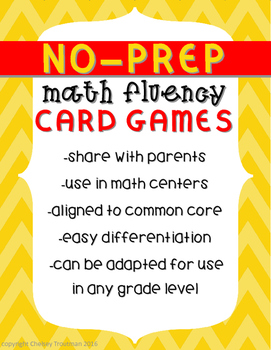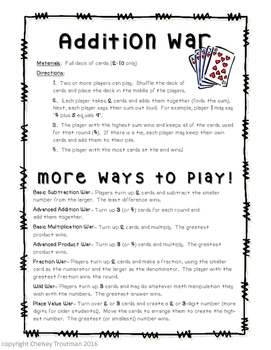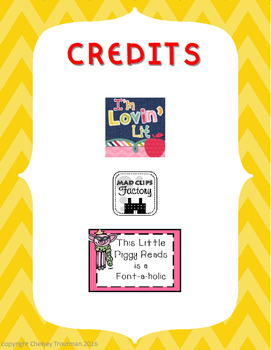Teach and Tech
220 Followers
Grade Levels
K - 6th, Homeschool
Subjects
Resource Type
Standards
CCSS1.NBT.B.2a
CCSS2.NBT.A.1
CCSS3.NBT.A.1
CCSS3.NBT.A.2
CCSSK.OA.A.1
Formats Included
- PDF
Pages
2 pages
Teach and Tech
220 Followers
Description
Show your students that math fluency can be FUN! Games are a great way to reinforce concepts learned in class and give students the extra practice to help them become fluent.
There are over 15 games included in this file. All you need is a deck of standard playing cards! My students play these games regularly in our math centers. They have made such great progress in their math fluency all while having fun.
I have also sent home copies to parents so they can help their child practice at home. These are great games to show parents at workshops and curriculum nights!
**TIPS**
-Introduce to students 1 game at a time in line with your instruction. This will allow them to learn the games and retain the rules without being overwhelmed.
-Make sure students are verbalizing basic facts. This will help them internalize the facts. You could also have students write them down on a piece of paper.
-Use in a guided math center. Keep the same rules for the games but change the content throughout the year to match your curriculum!
-Print off copies to send home with parents at the beginning of the year. Let them know when their child has learned a new game from the list so they can play at home.
-Set up a table at your next PTA night and encourage students to play against their friends and family!
There are over 15 games included in this file. All you need is a deck of standard playing cards! My students play these games regularly in our math centers. They have made such great progress in their math fluency all while having fun.
I have also sent home copies to parents so they can help their child practice at home. These are great games to show parents at workshops and curriculum nights!
**TIPS**
-Introduce to students 1 game at a time in line with your instruction. This will allow them to learn the games and retain the rules without being overwhelmed.
-Make sure students are verbalizing basic facts. This will help them internalize the facts. You could also have students write them down on a piece of paper.
-Use in a guided math center. Keep the same rules for the games but change the content throughout the year to match your curriculum!
-Print off copies to send home with parents at the beginning of the year. Let them know when their child has learned a new game from the list so they can play at home.
-Set up a table at your next PTA night and encourage students to play against their friends and family!
Total Pages
2 pages
Answer Key
N/A
Teaching Duration
N/A
Report this resource to TPT
Reported resources will be reviewed by our team. Report this resource to let us know if this resource violates TPT’s content guidelines.
Standards
to see state-specific standards (only available in the US).
CCSS1.NBT.B.2a
10 can be thought of as a bundle of ten ones - called a “ten.”
CCSS2.NBT.A.1
Understand that the three digits of a three-digit number represent amounts of hundreds, tens, and ones; e.g., 706 equals 7 hundreds, 0 tens, and 6 ones. Understand the following as special cases:
CCSS3.NBT.A.1
Use place value understanding to round whole numbers to the nearest 10 or 100.
CCSS3.NBT.A.2
Fluently add and subtract within 1000 using strategies and algorithms based on place value, properties of operations, and/or the relationship between addition and subtraction.
CCSSK.OA.A.1
Represent addition and subtraction with objects, fingers, mental images, drawings, sounds (e.g., claps), acting out situations, verbal explanations, expressions, or equations.





